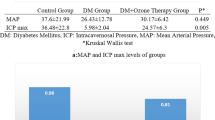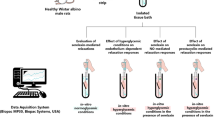Abstract
Prostaglandin E1 leads to penile erection, mainly via prostaglandin E2 (EP) receptors. This study aimed to identify the expression profile of EP receptor genes in human corpus cavernosum. Using the quantitative real-time reverse transcription polymerase chain reaction, the mRNA levels of EP receptor subtypes were measured. In addition, expressions of EP receptor subtype proteins were determined by immunohistochemical method. Among the four subtypes, EP4 receptor mRNA expression was the highest, and EP2 receptor mRNA followed, whereas EP1 and EP3 receptor mRNAs were hardly observed. Expression level of EP4 receptor mRNA was significantly higher than that of EP2 receptor mRNA. Expression of both EP2 and EP4 receptor proteins were clearly detected in the cavernous smooth muscle. These results may suggest that EP4 receptor plays an important role among four EP receptor subtypes for relaxation of smooth muscle in the human corpus cavernosum.
This is a preview of subscription content, access via your institution
Access options
Subscribe to this journal
Receive 8 print issues and online access
$259.00 per year
only $32.38 per issue
Buy this article
- Purchase on Springer Link
- Instant access to full article PDF
Prices may be subject to local taxes which are calculated during checkout



Similar content being viewed by others
References
Goldstein I, Lue TF, Padma-Nathan H, Rosen RC, Steers WD, Wicker PA . Oral sildenafil in the treatment of erectile dysfunction. New Engl J Med 1998; 338: 1397–1404.
Stackl W, Hasun R, Marberger M . Intracavernous injection of prostaglandin E1 in impotent men. J Urol 1988; 140: 66–68.
Porst H . The rationale for prostaglandin E1 in erectile failure: a survey of worldwide experience. J Urol 1996; 155: 802–815.
Rajasekaran M, Pagnon V, Monga M . Vasoactive agents induce cytotoxicity in cultured human penile smooth muscle cells. Urology 2002; 59: 155–158.
Coleman RA, Smith WL, Narumiya S . International Union of Pharmacology classification of prostanoid receptors: properties, distribution, and structure of the receptors and their subtypes. Pharmacol Rev 1994; 46: 205–229.
Wittwer CT, Herrmann MG, Moss AA, Rasmussen RP . Continuous fluorescence monitoring of rapid cycle DNA amplification. Biotechniques 1997; 22: 130–138.
Morath R, Klein T, Seyberth HW, Nusing RM . Immunolocalization of the four prostaglandin E2 receptor proteins EP1, EP2, EP3, and EP4 in human kidney. J Am Soc Nephrol 1999; 10: 1851–1860.
Schmittgen TD, Zakrajsek BA . Effect of experimental treatment on housekeeping gene expression: validation by real-time, quantitative RT-PCR. J Biochem Biophys Methods 2000; 46: 69–81.
Nazarenko I, Lowe B, Darfler M, Ikonomi P, Schuster D, Rashtchian A . Multiplex quantitative PCR using self-quenched primers labeled with a single fluorophore. Nucleic Acids Res 2002; 30: e37.
Kamphuis W, Schneemann A, van Beek LM, Smit AB, Hoyng PF, Koya E . Prostanoid receptor gene expression profile in human trabecular meshwork: a quantitative real-time PCR approach. Invest Ophthalmol Vis Sci 2001; 42: 3209–3215.
Dhar AK, Roux MM, Klimpel KR . Detection and quantification of infectious hypodermal and hematopoietic necrosis virus and white spot virus in shrimp using real-time quantitative PCR and SYBR Green chemistry. J Clin Microbiol 2001; 39: 2835–2845.
Angulo J, Cuevas P, La Fuente JM, Pomerol JM, Ruiz-Castane E, Puigvert A et al. Regulation of human penile smooth muscle tone by prostanoid receptors. Br J Pharmacol 2002; 136: 23–30.
Abramovitz M, Adam M, Boie Y, Carriere M, Denis D, Godbout C et al. The utilization of recombinant prostanoid receptors to determine the affinities and selectivities of prostaglandins and related analogs. Biochim Biophys Acta 2000; 1483: 285–293.
Moreland RB, Kim N, Nehra A, Goldstein I, Traish A . Functional prostaglandin E (EP) receptors in human penile corpus cavernosum. Int J Impot Res 2003; 15: 362–368.
Moreland RB, Albadawi H, Bratton C, Patton G, Goldstein I, Traish A et al. O2-dependent prostanoid synthesis activates functional PGE receptors on corpus cavernosum smooth muscle. Am J Physiol Heart Circ Physiol 2001; 281: H552–H588.
Kotani M, Tanaka I, Ogawa Y, Usui T, Tamura N, Mori K et al. Structural organization of the human prostaglandin EP3 receptor subtype gene (PTGER3). Genomics 1997; 40: 425–434.
Maruyama T, Kuwabe SI, Kawanaka Y, Shiraishi T, Shinagawa Y, Sakata K et al. Design and synthesis of a selective EP4-receptor agonist. Part 4: Practical synthesis and biological evaluation of a novel highly selective EP4-receptor agonist. Bioorg Med Chem 2002; 10: 2103–2110.
Kajino H, Taniguchi T, Fujieda K, Ushikubi F, Muramatsu I . An EP4 receptor agonist prevents indomethacin-induced closure of rat ductus arteriosus in vivo. Pediatr Res 2004; 56: 586–590.
Kabashima K, Saji T, Murata T, Nagamachi M, Matsuoka T, Segi E et al. The prostaglandin receptor EP4 suppresses colitis, mucosal damage and CD4 cell activation in the gut. J Clin Invest 2002; 109: 883–893.
Bastepe M, Ashby B . Identification of a region of the C-terminal domain involved in short-term desensitization of the prostaglandin EP4 receptor. Brit J Pharmacol 1999; 126: 365–371.
Desai S, April H, Nwaneshiudu C, Ashby B . Comparison of agonist-induced internalization of the human EP2 and EP4 prostaglandin receptors: role of the carboxyl terminus in EP4 receptor sequestration. Mol Pharmacol 2000; 58: 1279–1286.
Acknowledgements
This work was supported in part by the Grant in-Aid for Scientific Research from the Ministry of Education, Culture, Sports, Science and Technology of Japan to Dr M Takeda (No. 14370508, 15639014 and 16659436), and to Dr I Araki (No. 16591588).
Author information
Authors and Affiliations
Corresponding author
Rights and permissions
About this article
Cite this article
Komuro, M., Kamiyama, M., Furuya, Y. et al. Gene and protein expression profiles of prostaglandin E2 receptor subtypes in the human corpus cavernosum. Int J Impot Res 18, 275–281 (2006). https://doi.org/10.1038/sj.ijir.3901408
Received:
Revised:
Accepted:
Published:
Issue Date:
DOI: https://doi.org/10.1038/sj.ijir.3901408
Keywords
This article is cited by
-
Pathways to relaxation of corporal smooth muscle
Current Sexual Health Reports (2006)



